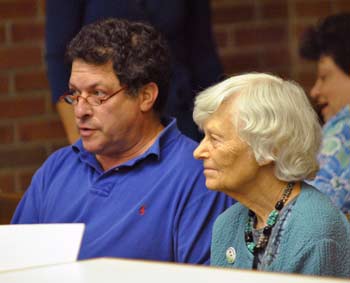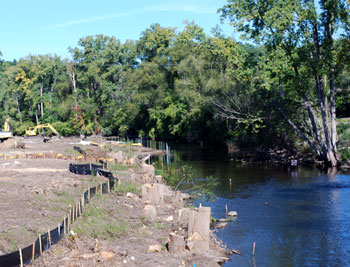PAC: Downtown Park, More Input Needed
Ann Arbor park advisory commission meeting (Sept. 18, 2012): Reprising issues they discussed in August, commissioners heard from several residents about the need for: (1) more downtown green/open space; and (2) one or more centrally located dog parks.

Eric Lipson and Mary Hathaway attended the Sept. 18, 2012 Ann Arbor park advisory commission meeting to advocate for more green space in the downtown area, specifically on top of the Library Lane parking structure. (Photos by the writer.)
PAC took action on one of those topics, passing a resolution to give formal input on the Connecting William Street project. That effort, led by the Ann Arbor Downtown Development Authority, is process to examine five city-owned parcels for possible redevelopment. All but one of the sites are now used as surface parking lots.
PAC did not advocate that a particular site be turned into a park. Rather, the resolution recommends that the Ann Arbor city council seek additional evaluation of locations for a downtown park, the best mix of amenities for the population expected to use a downtown park, and the costs of developing and maintaining a new addition to the parks system. PAC also recommends that the council refrain from adopting plans for the five city-owned lots before resolving the question about open space in the Connecting William Street area. [.pdf of final Connecting William Street resolution]
At the start of the meeting, three members of the Library Green Conservancy – advocates of creating a commons on top of the Library Lane underground parking structure – spoke during public commentary. [The Library Lane site is one of the five properties included in the Connecting William Street project.] They urged commissioners to support their plan for a park at that location, adjacent to the library. The underground structure was built with a foundation to support a high-rise building on the site, in addition to a plaza area. PAC’s recommendation to the city council did not highlight that particular site.
Also during the meeting, commissioners heard from two speakers during public commentary who supported the creation of more dog parks. One speaker noted that despite potential problems – such as dog fights and the fact that ”pooping can occasionally go unnoticed” – a dog park poses no greater liability than a skatepark, pool or “even simply sidewalks.”
Colin Smith, the parks and recreation manager, told commissioners that staff did not support an unfenced option, but indicated that they’re exploring possible locations for one or more fenced-in dog parks. One possible site: A parcel on the east side of West Park, near the entrance off of Chapin.
PAC also was briefed on plans for rain gardens and other biodetention measures at Miller Nature Area and Garden Homes Park, in connection with a major reconstruction of Miller Avenue next year.
Smith also updated commissioners on letters of objection that had been submitted to the Michigan Dept. of Environmental Quality (MDEQ) regarding plans to build a section of whitewater in the Huron River, near the Argo Cascades. A permit is needed from the MDEQ before the project can move forward. For a full report on this issue, see Chronicle coverage: “EPA, Others Object to Whitewater Project.”
It was the last meeting for commissioner Doug Chapman, whose term ended on Sept. 30. At the city council’s Oct. 1 meeting, his replacement was confirmed: Melissa Stults, a doctoral student at the University of Michigan’s Taubman College of Architecture and Urban Planning. [Full Story]




